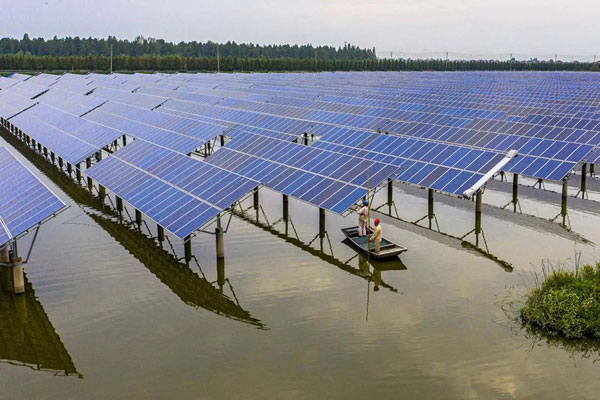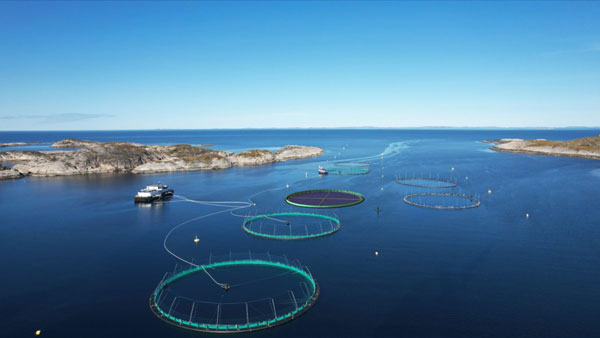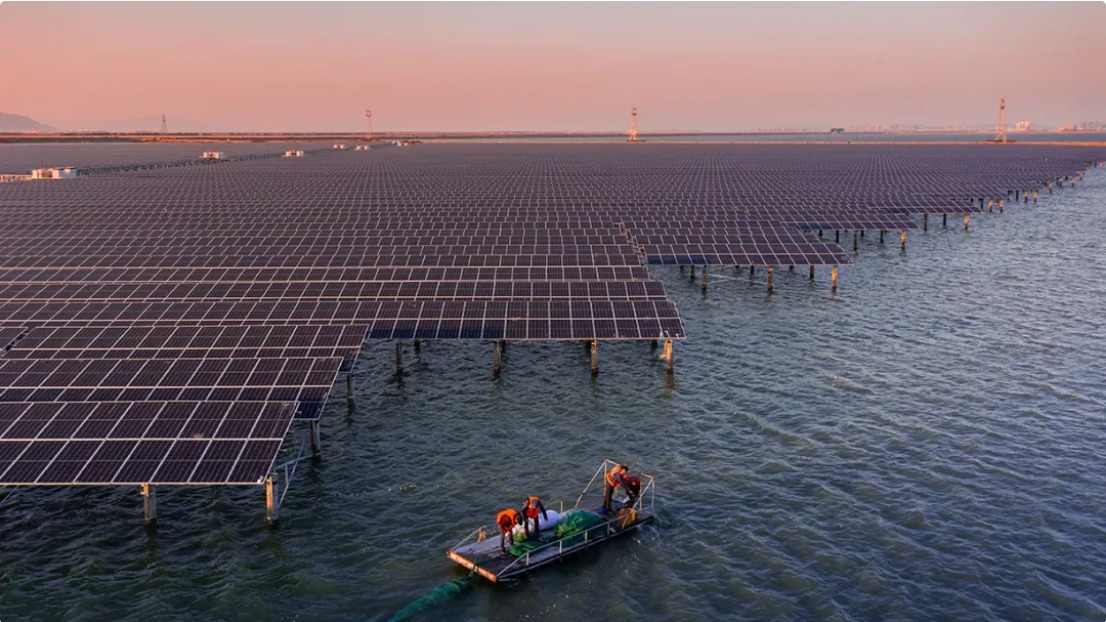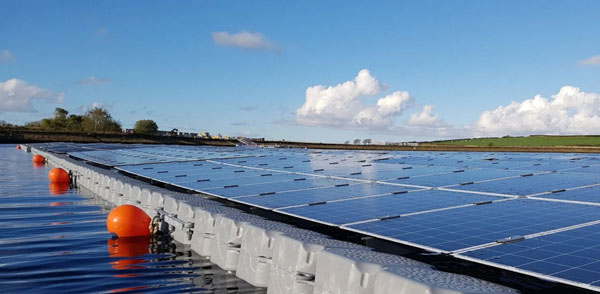Energy Audit
In order to set up a solar energy system in aquaculture, a detailed energy audit should be conducted to determine the baseline energy consumption and identify weak points. This involves gathering quantitative information on energy use patterns among different components of the aquacultures system.

Installation of Solar Panels
The installation of solar panels such as placement and maximum exposure to sunlight is critical. For instance, a shrimp farm in Florida has over 150 solar panels placed over its nursery ponds since exposure to sunlight was the highest at the location. Ventilation costs, such as water aeration, were decreased by 60% . The site is surveyed in order to track the whereabouts of the panels, after which panels can be mounted and connected with aquaculture equipment by wires. The conversion of solar energy to electricity can be done using controllers which convert it to the energy acceptable to the system. The electricity is then fed into the control center of the farm. Proper electrical wiring must be done in order to ensure that it is properly connected to the grid. The existing sources of energy have to be separated from the solar ones. The wiring must also be properly fused in order to maintain the safety of both the panels and the farm machinery.
Energy Storage
Energy storage is essential in order to account for the intermittent nature of the solar power. Thus, a fish farm in California also hosts a 200 kWh battery system which they employ to store the solar power that was not spent during the day. They then use it at night to operate pond aerators and water pumps. This is done in order to provide constant energy supply.
System Integration and Automation
In many cases, the integration of a solar system with the already existing aquaculture system means that a case for automation is made. Not all traditional fish and shrimp farm systems have automatic ones. For instance, a tilapia farm in Arizona has an automated control system put in place so that solar energy is used perfectly by systems such as fish feeding mechanisms and oxygenators.
Performance Monitoring
The constant monitoring of the solar system is essential for prolonged service. At least the data that can be included in different models have to be gathered and analyzed on a weekly basis. For instance, too sudden changes can be quickly observed through the monitoring systems. In addition, regular checkups also have to take place. For instance, electricity consumption differences could indicate that the system is out of order.
System Design
The process of designing a solar energy system for aquaculture is slightly more intricate than for other purposes and involves precise engineering to cater to the specifics of an aquatic environment. This process typically includes selecting the type of solar panel, planning the layout, and calculating expected outcomes to ensure that they correspond with the needs of the aquaculture facility in question.
Solar Panel Type and Configuration
The selection of the most appropriate type of solar panel is determined by a number of factors, including climate, space availability, and energy generation capacity. At a catfish farm in Mississippi, polycrystalline solar panels were chosen due to their cost efficiency and suitability for humid climate conditions. The farm installed 200 Nielsen solar panels, each rated at 330 watts. They were placed in sites that were most effective in capturing the sunlight. Such decision was explained by the fact that this type of panels requires minimal space to produce optimal energy and can be accurately positioned. Assessment of Energy Needs The process of energy needs assessment is critical in ensuring the high performance and effectiveness of a solar system. Therefore, it requires a close examination of power consumption of water pumps, aerators, and feed distribution mechanism among other measures. At a trout farm in Colorado, the assessment revealed that the farm currently required 1,200 kWh per day to preserve the necessary quality of water and maintain the health of the fish.
Layout Planning
Effective planning of the layout of such systems is also essential because it should equally take into account sunlight exposure and facilities’ operations. The salmon hatchery in Oregon demonstrated accurate placement of solar batteries on all available roof space and surrounding areas, which did not interfere with the working zones of the farm. Such decision helped to make the facility more energy-efficient and exploit less useful land. Integration with Aquaculture Systems Finally, the tight integration with the aquaculture system implies that the energy produced by solar panels must be directly connected to the system and the installation of power management software needed for real-time energy distribution.
Permit Acquisition
To legally install a solar energy system in aquaculture, one must be able to maneuver the permit acquisition process. While depending greatly on local regulation, the process includes a few common requirements, such as administering an environmental standard and understanding the regulations.
Understanding Local Regulations
First and foremost, is the ability to properly grasp, understand local, and regional regulations, which should set the due course for placing the solar energy systems. The branch of fish farming is far-reaching and unique; therefore, the differences between the regulations of two sorts of institutions can be vast. A perch farm in Wisconsin had to follow the law of the state and local county, which required a site plan and an examination of the solar farm’s environmental impact. The planning process was an ambitious project that took quite a lot of time to implement.
Documentation and Compliance
Paperwork is a vital part of the process, yet it is a rather arduous and complex one. A comprehensive site plan along with engineering drawings, estimation of energy production, and an environmental plan for the future were necessary for a permit to be approved, acquired, and issued. An oyster farm in Virginia, for instance, had to also present case scenarios of the effect of the solar energy on shade-long evolution of native species and water quality impacts. To obtain a permit from the state, plans must meet the minimum decree standards, yet this is not all.
Lines of Communication
Another important factor is effective communication with related officials, which might just as well expedite the process. A Fresno tilapia farm had a hired liaison, privy to both the knowledge of the law and of the service, to navigate the process. Within three months, after starting the process of obtaining a permit, the installers could finally start working on acquiring the permits. The California water use subsidiary issues permits six months after request; yet, the proximity of the process to state law could have caused a faster delay.
Environmental Impact Assessments
The last step, which turned out to be necessary in both previous, examples is the conduction and the passage of the appropriately registered environmental impact assessment. The study is conducted with the view of measuring the impact of the impending solar farms on the local wildlife. The bass farm in Alabama study was completed over a month and a half, estimating both the shade length and the footprints of ground intrusion. They found it to be a minimal impact so the permits were issued a few months before the time of request for assistance.
Installation
This is the final phase in the process, and it involves the actual installation of the solar energy system. This is a complex and technical process that has to be done meticulously. This phase is also quite broad and includes installing the physical equipment that includes solar panels, their integration into the existing structure at the site, and initial testing to ensure that it all works as it was designed.
Site preparation
Before we start installing any equipment, we first prepare the sites. This includes modifying and upgrading the structures that will support the solar panels and on which we will attach the panels. At the tilapia farm, we did most of the work on reinforcing pond banks, which had to take the heaviest burden of the load. The second part of the installation of solar panels was to upgrade the structures of the feed storage areas. Both types of roofs had the same level of extra steel added at the back end of the buildings, and they were both completed with a final load capacity of 30 pounds per square foot.
Mounting the solar panels
This is a part of the installation process where the amount of work greatly varies depending on the solar energy system and environment. The most straightforward installation process may be the one at the trout farm, where they decided to have all the panels standing on the ground without integration into any existing mounting buildings. The mounting and testing of solar panels also do not include any GBI/Electric III work. At the trout farm, we have done all the work of mounting steel mounting frames for the solar panels, securing 250 solar panels to the frames. It took us over two weeks to accomplish this major span of our work.
Electrical integration
Integrating the solar system with the farm’s electrical system is essential for its functionality. We also install wiring and a range of protective devices, like surge protectors and circuit breakers. At the salmon hatchery, professionals installed state-of-the-art inverters that can peak up to 500 kWh. The work also includes connecting the work of electrical contractors to the farm and grid supply, allowing displacement and feeding back of energy.

Grid Integration
One of the most complex and necessary steps in the process of implementing a solar energy system integrated with the electrical grid in aquaculture, equipment setup, and connection is a critical precondition of farm energy reliability and sustainability. The phase involves a range of technical setups, such as configuring grid connections and handling net metering arrangements, as well as compliance with a series of energy regulations.
Configuration of Grid Connections
On the one hand, the process of configuring grid connections is related to other technical aspects, including net metering and dual meter arrangements and, on the other hand, the setup process involved extensive technical finalization work. In Anthony Wayne’s farm in New York, for instance, engineers tapped into the grid to press solar power into public utility systems. Further, smart inverters were installed to control the flow of energy, and dual meters enhance the process of energy measurement, both for the amount of energy used by the farm as well as sold into the grid. The farm typically “sells off superfluous [sic] electricity in the afternoons, generally between 1 and 2 pm.”
Net Metering Setup
Net metering is a billing mechanism which accumulates value, thus allowing to new system owners to transfer the cost of their solar energy to the utility company. The process of net metering setup, mandates, firstly, collaboration with the local utility in the ban of billing and monitoring, since the system should account for what the farm uses as well as sends into the grid, and, secondly, maximized economic benefits from energy sold by fish farm. In A. Grenell’s bass farm in Virginia, for example, the installation process presupposes an arrangement with the local utility to credit “ the farm for any excess power generated.”
Compliance with Energy Regulations
A mollusk hatchery in Oregon, for example, had to undergo and pay for a review of compliance with a long series of local and national energy laws. As a result, the system had to install “devices required to prevent ‘back-feeding’ into the circuit it is connected to.” Additionally, the farm had to provide regular reports on performance to the Energy Commission.
Testing and Final Approval
After installation, the process of testing and connecting to the grid involves a series of electrical and other tests, including, for example, load tests in Mr. Douglas’s farm in Florida. This parplestart involves making emergency cuts and examining the system’s response in the context of broader grid integrity.
Monitoring
Effective monitoring of a solar energy system in aquaculture helps the system to operate at full capacity and spot issues before they grow into a crucial problem. This step includes implementing real-time monitoring tools, data analysis to support optimal performance, and regular maintenance.
Real-Time Monitoring Tools
Implementation of real-time monitoring tools is important for tracking a solar energy system’s performance. In a sturgeon farm in California, solar power output, battery levels, and the energy used from the grid are monitored using an integrated software platform. The system sends alerts of the system deviating from the expected norm. An example can include an alert of a sudden drop in power generated from the system due to the system being covered by snow or there are faults.
Data Analysis for Optimization
Regular data analysis is crucial for the interpretation of trends and optimization of the solar energy system. A game farm in Harere, Texas, was analyzed for its energy usage to optimize a solar system to be implemented in a prawn farm in the same area of a land. The review of data showed that the conclusion that modeling solar panels back for the winter months and front for the summer months can lead to an increase of energy captured by 15%. Such recommendations are drawn following the analysis of the historical weather data and the energy usage by the farm.
Scheduled Maintenance
Regular maintenance is critical to preserve the system’s efficacy and service life. For example, a catfish farm in Etta, Mississippi, has bi-annual maintenance checks, which predominantly involve cleaning of the panels from debris and dust, inspection of connections and wiring, and testing of inverters.
Response Strategies for Anomalies
Response strategies for spotted anomalies will help to ensure minimum runtime and cost-effectiveness. For example, when a solar panel fault was detected in a salmon hatchery in Burien, Washington, the farm had a predetermined scenario. This included immediate remote troubleshooting and an in-site visit to return the system in operation within 48 hours.
Maintenance
Maintenance is vital for the long life and proper work of a solar energy system. Such maintenance is a series of planned actions that prevent breakage and make it work as effectively as possible. Some critical components of a solar energy system in aquaculture, particularly solar panels, batteries, inverters, and before-mentioned components’ electrical connections, ought to be maintained regularly.
Monthly Cleaning and Inspection of Solar Panels
The first kind of regular maintenance to mention, beside the annual or semi-annual checking, is the constant cleaning of solar panels. In Florida at a barramundi farm, a pilot commercial facility has been run. It is reported that polarity was an issue, and silicon panels were damaged. Their maintenance schedule called for a month-by-month cleaning of the solar panels with the collection of performance data. This simple kind of maintenance increased energy output by 20% in the worst pollen-heavy spring months, and there was still visible silica buildup on the panels.
Battery Health Checks
Battery maintenance is a question of utmost importance for the solar energy system because it is the component that may fail and destabilize the whole system. At a lobster hatchery in Maine, battery maintenance schedule calls for a quarterly check-up of batteries’ voltage and charge to ensure that their storage capacity does not fall below 80% of its original maximum. Because batteries may fail due to various issues, even a solar energy system requires power at night and on cloudy and rainy days.
Inverter and Connection Auditing
Likewise, inverters and electrical connections are the solar system’s backbone. At a catfish operation in Alabama, a semi-regular inverter and connection examinations are performed. Regular maintenance involves the testing of inverters’ ability to convert solar power no less than a rate established in the manufacture. Connection checking is performed, and before-mentioned connections are power tightening. This type of maintenance proved having a 99.5% success rate.
Continuous Improvement
To begin with, the implementation of continuous improvement methods helps in effectively controlling, and managing solar systems in aquaculture. Review and updated crop or livestock management software to include the latest advances: “aqua-management, for example, the system is important”. Furthermore, the implementation of the approach involves the number of important steps such as regular performance reviews, integration of newer solar technologies, and training staff to handle existing and potential challenges. Specifically, the key steps in the implementation of the approach were the performance reviews and the review of older models by integrating newer solar technologies.
Performance Analytics and Review
Continuously review performance and find areas of enhancement. For example, a trout farm in Colorado installed a state-of-the-art data analytics platform, which analyzed the performance of solar output, on-farm energy consumption and the system every quarter. It’s important to note that the regular review of such an approach helped to improve energy utilization on the farm by 10%. Specifically, as the results of the performance analysis show and the review of the technology, it was integrated into the system to help eliminate system inefficiencies previously detected in the review process.
Technology Upgrades
Keep up with the advancements of solar technologies. For example, a catfish farm in Mississippi integrated a newer solar panel type after it became available. According to sources, 20% of older panels on the catfish farm were replaced with 15% more efficient models. More than that, the system performance shows that the technology provided a substantial increase in energy production 6 months following installation.
Staff Training and Development
Implement regular training systems. For example, a shrimp farm in Louisiana has regular biannual workshops for all technicians on the latest state-of-the-art solar trends and improved problem shooting methodologies. The farm reports improved operational efficiency with 30% reduced downtime.



